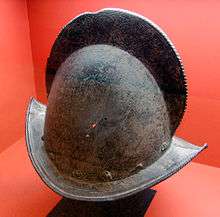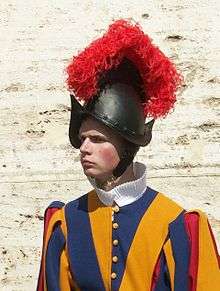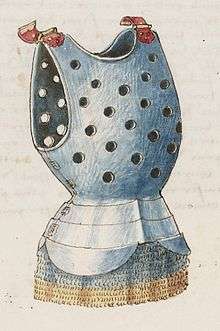Morion (helmet)

A morion is a type of open helmet used from the middle 16th to early 17th centuries, usually having a flat brim and a crest from front to back. Its introduction was contemporaneous with the exploration of North, Central, and South America. Explorers like Hernando de Soto and Coronado may have supplied them to their foot soldiers in the 1540s.
History
The iconic morion, though popularly identified with early Spanish explorers and conquistadors, was not in use as early as the conquest of Mexico by Hernan Cortez or Francisco Pizarro's conquest of the Incas in South America. Thirty to forty years later, it was widely used by the Spanish, but also common among foot soldiers of many European nationalities, including the English; the first English morions were issued during the reign of Edward VI.[1] Low production costs aided its popularity and dissemination although officers and elite guards[2] would have theirs elaborately engraved to display their wealth and status.[3][4]
The crest or comb on the top of the helmet was designed to strengthen it. Later versions also had cheek guards and even removable faceplates to protect the soldier from sword cuts.[5]
The morion's shape is derived from that of an older helmet, the Chapel de Fer, or "Kettle Hat."[6] Other sources suggest it was based on Moorish armor and its name is derived from Moro, the Spanish word for Moor.[7] The New Oxford American Dictionary, however, derives it from Spanish morrión, from morro 'round object'.[8] The Dictionary of the Spanish Language published by the Royal Spanish Academy indicates that the Spanish term for the helmet, morrión, derives from the noun morra, which means "the upper part of the head".[9]
In England this helmet (also known as the pikeman's pot) is associated with the New Model Army, one of the first professional militaries.[10] It was worn by pikemen, together with a breastplate and buff coat as they stood in phalanx-like pike and shot formations, protecting the flanks of the unarmored musketeers.[11]
It provided protection during the push of pike maneuvers known for their high casualty rates.[12] Although mostly issued to Oliver Cromwell's Parliamentarian troops, many Cavaliers wore the morion as well, leading to confusion in battles; soldiers risked being shot by their own allies. It was for this reason uniforms were introduced to identify armies. First these were simple colored sashes but soon the Roundheads introduced red coats which were retained by the army after the 1660 Restoration of Charles II.[13]
Surviving morions from its 1648 siege have been unearthed and preserved at Colchester Castle[14] along with a lobster tail pot, a helmet associated with Cromwell's heavily armored Ironside cavalry.
Some captured Spanish armor was worn by Native Americans as late as the 19th century as protection from bullets and a sign of their status.[15] The most famous of these was the Comanche chief Iron Jacket who lived in Texas and wore armor that originally belonged to a conquistador.[16]
In the Philippines, the native Moro people adopted the morion and burgonet design for helmets (as well as chainmail and horn coats) during the Spanish–Moro Wars and the Moro Rebellion. The indigenously produced helmets are usually made of iron or brass and are elaborately decorated with floral arabesque designs, usually in silver. They had a large visor and neck guard, movable cheek guards, a high crest, and three very tall feathered plumes reaching 60 cm (24 in) inserted on the front.[17][18]
Cabasset

A similar helmet, the cabasset, was introduced around the same time in Italy.[19] Like its Spanish counterpart, it was worn by infantry in the pike and shot formations. The stalk-like projection on the top resembled a pear, which is how it gained its name.[20] [21] It was popular in 16th century England and was used during the Civil War. Several of these helmets were taken to the New World by the Pilgrim fathers, and one of these has been found on Jamestown Island.[22]
Modern times

- The morion may have influenced the design of the Adrian Helmet issued to French and Italian troops during World War I. Both are of a similar shape and have a comb reinforcing the top of the helmet.[23]
- The comb morion (with a red crest added) is part of the uniform of the Pope's Swiss Guards.[24] A Swiss guardsman in his morion appears on the Vatican City commemorative 2 Euro coin.
- From 1928 until 1961, the morion served as the logo of automobile manufacturer DeSoto, named after the 16th century explorer Hernando de Soto. It appeared as the hood ornament on cars of the 1940s and 1950s like the DeSoto Deluxe.[25]
- The seal of the city of Cupertino, California, includes a morion.
- The morion appears on the insignia of the 53rd Infantry Brigade Combat Team, the largest of the Florida Army National Guard, in tribute to the early militias of Florida under Spanish rule.
In popular culture
- Helmets like the morion and cabasset feature in historical dramas set in the Elizabethan period, generally worn by extras portraying guards.[26] Such works include the films Elizabeth: The Golden Age, Cromwell, Witchfinder General and BBC TV series like The Tudors and Blackadder 2.[27]
- In both the stage and film versions of the musical Man of La Mancha, the soldiers of the Spanish Inquisition all wear morion helmets, and in the film (but not the play), Don Quixote's helmet is a morion with a makeshift visor artificially attached to it, as Cervantes describes in his novel Don Quixote de la Mancha. (The play uses a regular knight's helmet with a non-makeshift visor.)
- In Dances With Wolves the Indian chief presents Lt. Dunbar with a morion.
- In the Disney movie Pocahontas, English soldiers like Captain John Smith wear morions.[28]
- Morions appear in the fantasy film The Chronicles of Narnia: Prince Caspian They are worn by the Telmarines, soldiers of the evil king Miraz and descendants of pirates from Earth.[29]
- In The Lord of the Rings: The Two Towers, orc sappers wearing morions plant explosives in the wall of Helm's Deep. Other Uruk-hai wear helmets resembling the lobster tail pot.
See also
References
| Wikimedia Commons has media related to Morion. |
| Wikimedia Commons has media related to cabasset. |
- ↑ European comb morion
- ↑ Morion, late 16th century, associated with the Munich town guard
- ↑ Morion by Pompeo della Cesa, Milan, 1585 - 1590 on view at Lennart Viebahn Arms & Armour
- ↑ Morion helmet
- ↑ Pikeman's Pot
- ↑ Spanish Conquistador Helmet - Comb Morion, helmet replica.
- ↑ Hermitage Museum
- ↑ New Oxford American Dictionary (2nd ed., 2005), p. 1102.
- ↑ Morrión, Diccionario de la Lengua Española, 22nd ed., 2001
- ↑ C.H. Firth. Cromwell's Army 4th ed., 1972, p. 70
- ↑ Eventplan photograph
- ↑ Oman, Charles. A History of the Art of War in the Sixteenth Century. London: Methuen & Co., 1937.
- ↑ Barthorp, Michael. British Infantry Uniforms Since 1660. Blandford Press 1982 Ltd, 1982. ISBN 1-85079-009-4
- ↑ Colchester Castle museum
- ↑ The Fighting Cheyennes, by George Bird Grinnell (2004)
- ↑ Iron Shirt
- ↑ Herbert W. Krieger (1899). The Collection of Primitive Weapons and Armor of the Philippine Islands in the United States National Museum. Smithsonian Institution - United States National Museum - Bulletin 137. Washington: Government Printing Office.
- ↑ George Cameron Stone (1934). A Glossary of the Construction, Decoration, and Use of Arms and Armor in All Countries and in All Times: Together with Some Closely Related Subjects. Southwork Press. p. 66.
- ↑ Encyclopedia of Historical Weapons
- ↑ Pear - Stalk Cabasset, Northern Italy, 1580 - 1590 on view at Lennart Viebahn Arms & Armour
- ↑ Cabasset replica
- ↑ Cabasset found at Jamestown
- ↑ Adrian helmet
- ↑ Swiss guards on the Vatican website
- ↑ Classic Desoto cars
- ↑ Footage from Elizabeth: The Golden Age
- ↑ Footage from Blackadder on YouTube
- ↑ Pocahontas at the Internet Movie Database
- ↑ Narnia on Disney website
